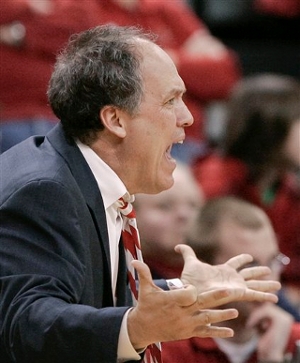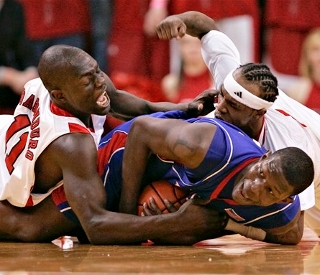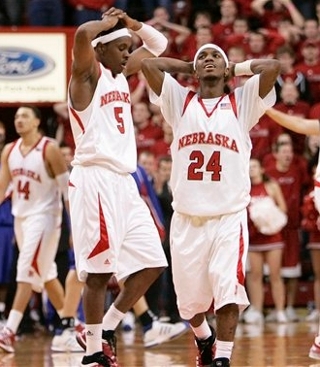Bob Devaney Sports Center | Lincoln, NE | Tip: 1 PM CST | TV: ESPN If there was ever a must-win game for the Texas Longhorns, this would be it. They have lost two straight games by a combined eight points, slipping to only .500 in conference play, where they sit just a half-game above the dreaded fifth-place line. So while it’s certainly time to stop the bleeding, the Longhorns have the unenviable task of doing so on the road against a very well-coached team that has historically takes them to the wire. Although Texas has defeated the Cornhuskers nine out of the ten meetings under Coach Rick Barnes, the last two meetings against new Nebraska coach Doc Sadler have been much more interesting. In 2006, the Longhorns escaped Lincoln with a one-point victory — a contest they also entered on a two-game losing skid — and won by only four last season in Austin. But if Tuesday night’s game against Missouri was the worst possible match-up for the Longhorns, this afternoon’s contest with Nebraska could be one of the best. The Huskers play a style of basketball that is nearly identical to Texas, but do it with a smaller, less-athletic team. If Texas plays sound basketball, they should escape Lincoln with another narrow victory.
Doc Sadler has led Nebraska’s turnaround By the numbers As we just mentioned, watching a Nebraska game can be eerily similar to watching this year’s Texas team. While the Longhorns average just 67.4 possessions per game, the Cornhuskers run things at a slightly slower pace, averaging 63.8 possessions. Today, Texas will not have to worry about dictating the pace of play or preventing from falling into a transition battle. It’s going to be a half-court slugfest, and the team that can best utilize their limited possessions will come out on top. The best measure of that skill is Ken Pomeroy’s efficiency metric, which represents how efficiently offenses and defenses work. Just as with the tempo statistic, these two teams are nearly identical in efficiency. Both Texas and Nebraska are solid defensive squads with slightly above-average offenses, and are so closely matched that their efficiency margins (offensive pts/poss – defensive pts/poss) differ by only .065, with Texas on top. If you were to extrapolate with the tempo these two teams play at, we should be looking at a game hovering around 60 points, with the winner clinging to a four-point margin of victory. It might be time to break out the Tums. Meet the Cornhuskers The biggest question coming into this season was how Doc Sadler would replace big man and go-to scoring option Aleks Maric. The Aussie averaged a double-double last season for Nebraska, putting in more than 15 points with 10 rebounds every night. Without him, the current incarnation of Cornhusker basketball is a four-guard look, with an unreliable “post” player inside that can hardly stay on the floor for five straight minutes.
Cookie Miller is fighting mad Miniscule Cookie Miller leads things at the point for Nebraska, checking in at an alleged 5-foot, 7-inches. But if Cookie is truly that tall, then Muggsy Bogues was a power forward. What Miller lacks in height and muscle, though, he makes up for in unabated scrappiness. He’s one of the fastest players on the floor, a fiesty defender, and has a knack for taking ridiculous-looking shots that somehow find their way in the hole. But perhaps most importantly, he is a quality floor general who keeps his teams turnovers low while dishing out nearly five assists per game. Although Sek Henry is third on the team in scoring with nine points a game, the thing Coach Sadler loves about him most is the quality defense he gives night in and night out. He’ll hassle your guards on the perimeter and make it hard for the offense to get started, and even provides about a steal per game. Senior Steve Harley leads the team in scoring, although that title changes from game to game. Entering this contest, Harley has 11.8 points per contest, and does it with solid jump shooting and nice range. He’s not the team’s best three-point shooter, hitting just over 36% of his long-range attempts. But Harley has an excellent mid-range jumper, and he can use it not just for the easy two, but also to pull the defense out and open up the driving lanes for the other three guards. The other main scoring threat for Coach Sadler is Ade Dagunduro, a 6’5″ swingman that has become the team’s de facto post presence. He is often matched up defensively with the biggest players that the opponents throw out there, and he’s not afraid to bang with the frontcourt players to earn his points. Ade is a very lengthy player with great handles that can drive the lane, but needs to step up his consistency in Big 12 play. He has had breakout, 20-plus point nights against quality teams such as Missouri and Kansas, but nearly disappeared on Wednesday against Colorado. If he has an off night, it will be much harder for Nebraska to grind out the win over the Longhorns. While the four guards run the show, Coach Sadler’s offense relies on one post player who can step out and set screens or start things from the high post. Junior Chris Balham fills that role in the starting lineup, although his propensity to collect fouls like Pokemon cards makes him nearly inconsequential in most games. He has yet to play more than fourteen minutes in a conference game, and it seems that even on nights when he’s not fouling indiscriminately, that the knee problems which have bothered him the last two seasons flare up once again.
It’s been an up-and-down year for Nebraska Off the bench For most of the season, Coach Sadler has gone with an eight-man rotation, but has lately been trying to expand his bench to include ten contributing players. With his defense-first philosophy, a deeper team is definitely going to be needed to last through the second half of conference play and into the post-season. Ryan Anderson is the biggest threat off the bench, and despite his 6’4″ frame, he often picks up the slack for Balham down low. He is actually the team’s leading rebounder, despite playing only 24 minutes per game, and he has no qualms about bodying up on defense in the paint. On offense, Anderson uses his long-range threat to make himself a true dual-threat player. He can knock down the three, or slash to the basket on a moment’s notice. Even though this junior is technically a bench player, he will be a big factor in today’s game. Another bench player who sees a solid chunk of minutes every night is three-point weapon Paul Velander. At one point just a few weeks ago, he actually led the nation in three-point accuracy, but has since slowed down in conference play. Even with the cold spell, he’s hitting over 44% of his threes this year, and will certainly cause a problem for a Texas team that allowed Kansas State to light them up from long range. Toney McCray is a smooth freshman wingman from Texas that Coach Sadler sees as the future of the team. And if you’ve seen the flashes of brilliance from this kid, you can tell why. McCray is only averaging 16 minutes per game, but has been seeing significant minutes in most of Nebraska’s conference games. He’s another guy who can knock down the three or glide to the rack, so look for him to make a few key buckets in this afternoon’s contest. Guard Brandon Richardson is one of the players that Coach Sadler is trying to work into the gameplan a little more as conference play rolls on. After not seeing the floor in the first four Big 12 games this year, Richardson has given quality minutes in the last four contests. He’s yet another quality three-point shooter, and you can tell he’s eager for more minutes by how hard he plays when he’s on the floor. Cole Salomon is the other player seeing more minutes in recent action, as he’s averaged more than ten minutes in the last three games after playing less than a minute per game during the first eighteen of the year. He’s not going to score many points, if any, but proved against Kansas that he was willing to crash the glass despite being just a 6’4″ guard. Keys to the game Give Dexter the ball – Dexter Pittman was a huge risk/reward proposition against Missouri, and it showed. While he set a career high with 25 points, it was his poor defense that let the better-conditioned Tigers blow past him for key buckets late in the game. But against Nebraska, he should have an absolute field day. There is absolutely no one on this Cornhusker team that can hope to defend him or outrebound him. And because Doc Sadler loves the slow, grind-it-out style of play, Dexter will not be out of place having to run up and down the floor. He can hide in the back of a zone defense — something Nebraska seemed to be completely confounded by when Colorado used it — and dominate on the offensive end. Destroy Nebraska on the glass – The Cornhuskers are one of the worst offensive rebounding teams in the country, — in fact, there are only six teams with poorer numbers in the NCAA — which means that they have to be incredibly efficient with the basketball. Part of the problem is that they are so severely undersized, but some of the blame also falls on the fact that they are so committed to defense that three Nebraska players are usually backpedaling as soon as the team’s shot is released. Texas has to limit the Cornhuskers to a bunch of one-shot possessions, and on the offensive end they must utilize their massive height advantage to extend their own possessions with timely rebounds. Control the basketball – Nebraska doesn’t run Missouri’s adopted “Forty Minutes of Hell” style of play, but they are very good when it comes to winning the turnover battle. Their +6.2 turnover margin ranks in the top five nationally, and it’s even more impressive when you stop to consider how few possessions there are in a typical Nebraska game. Their opponents average 18 turnovers per contest, so when there’s less than 64 possessions in a game, that leaves Texas with very, very little margin for error. |











